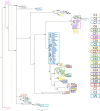Analysis of intact prophages in genomes of Paenibacillus larvae: An important pathogen for bees
- PMID: 35923395
- PMCID: PMC9341999
- DOI: 10.3389/fmicb.2022.903861
Analysis of intact prophages in genomes of Paenibacillus larvae: An important pathogen for bees
Abstract
Paenibacillus larvae is the etiological agent of American Foulbrood (AFB), a highly contagious and worldwide spread bacterial disease that affects honeybee brood. In this study, all complete P. larvae genomes available on the NCBI database were analyzed in order to detect presence of prophages using the PHASTER software. A total of 55 intact prophages were identified in 11 P. larvae genomes (5.0 ± 2.3 per genome) and were further investigated for the presence of genes encoding relevant traits related to P. larvae. A closer look at the prophage genomes revealed the presence of several putative genes such as metabolic and antimicrobial resistance genes, toxins or bacteriocins, potentially influencing host performance. Some of the coding DNA sequences (CDS) were present in all ERIC-genotypes, while others were only found in a specific genotype. While CDS encoding toxins and antitoxins such as HicB and MazE were found in prophages of all bacterial genotypes, others, from the same category, were provided by prophages particularly to ERIC I (enhancin-like toxin), ERIC II (antitoxin SocA) and ERIC V strains (subunit of Panton-Valentine leukocidin system (PVL) LukF-PV). This is the first in-depth analysis of P. larvae prophages. It provides better knowledge on their impact in the evolution of virulence and fitness of P. larvae, by discovering new features assigned by the viruses.
Keywords: Paenibacillus larvae; bacterial evolution; bacterial fitness; bacterial virulence; prophage.
Copyright © 2022 Ribeiro, Nilsson, Melo and Oliveira.
Conflict of interest statement
The authors declare that the research was conducted in the absence of any commercial or financial relationships that could be construed as a potential conflict of interest.
Figures





Similar articles
-
Discovery of Paenibacillus larvae ERIC V: Phenotypic and genomic comparison to genotypes ERIC I-IV reveal different inventories of virulence factors which correlate with epidemiological prevalences of American Foulbrood.Int J Med Microbiol. 2020 Feb;310(2):151394. doi: 10.1016/j.ijmm.2020.151394. Epub 2020 Jan 16. Int J Med Microbiol. 2020. PMID: 31959580
-
Phenotypic characterization and ERIC-PCR based genotyping of Paenibacillus larvae isolates recovered from American foulbrood outbreaks in honey bees from Italy.Vet Q. 2015 Mar;35(1):27-32. doi: 10.1080/01652176.2014.993095. Epub 2014 Dec 23. Vet Q. 2015. PMID: 25431956
-
The Buzz about ADP-Ribosylation Toxins from Paenibacillus larvae, the Causative Agent of American Foulbrood in Honey Bees.Toxins (Basel). 2021 Feb 16;13(2):151. doi: 10.3390/toxins13020151. Toxins (Basel). 2021. PMID: 33669183 Free PMC article. Review.
-
Identification and functional analysis of the S-layer protein SplA of Paenibacillus larvae, the causative agent of American Foulbrood of honey bees.PLoS Pathog. 2012;8(5):e1002716. doi: 10.1371/journal.ppat.1002716. Epub 2012 May 17. PLoS Pathog. 2012. PMID: 22615573 Free PMC article.
-
Paenibacillus larvae and American foulbrood in honeybees.Berl Munch Tierarztl Wochenschr. 2007 Jan-Feb;120(1-2):26-33. Berl Munch Tierarztl Wochenschr. 2007. PMID: 17290940 Review.
Cited by
-
Paenibacillus larvae and their phages; a community science approach to discovery and initial testing of prophylactic phage cocktails against American Foulbrood in New Zealand.Microbiome Res Rep. 2023 Aug 1;2(4):30. doi: 10.20517/mrr.2023.16. eCollection 2023. Microbiome Res Rep. 2023. PMID: 38045927 Free PMC article.
-
Gene content, phage cycle regulation model and prophage inactivation disclosed by prophage genomics in the Helicobacter pylori Genome Project.Gut Microbes. 2024 Jan-Dec;16(1):2379440. doi: 10.1080/19490976.2024.2379440. Epub 2024 Aug 12. Gut Microbes. 2024. PMID: 39132840 Free PMC article.
-
Characterization and Genome Comparison of Bacteriophage KKU62-1 Infecting Hypervirulent Streptococcus agalactiae ST283.Curr Microbiol. 2025 Aug 18;82(10):464. doi: 10.1007/s00284-025-04439-z. Curr Microbiol. 2025. PMID: 40824427
-
Characterization of prophages in bacterial genomes from the honey bee (Apis mellifera) gut microbiome.PeerJ. 2023 Jun 9;11:e15383. doi: 10.7717/peerj.15383. eCollection 2023. PeerJ. 2023. PMID: 37312882 Free PMC article.
-
Diverse Prophage Elements of Salmonella enterica Serovars Show Potential Roles in Bacterial Pathogenicity.Cells. 2024 Mar 14;13(6):514. doi: 10.3390/cells13060514. Cells. 2024. PMID: 38534358 Free PMC article.
References
-
- Aksyuk A. A., Bowman V. D., Kaufmann B., Fields C., Klose T., Holdaway H. A., et al. . (2012). Structural investigations of a Podoviridae streptococcus phage C1, implicationsfor the mechanism of viral entry. Proc. Natl. Acad. Sci. U. S. A. 109, 14001–14006. doi: 10.1073/pnas.1207730109, PMID: - DOI - PMC - PubMed
-
- Alippi A., Lopez A., Aguilar O. (2002). Differentiation of Paenibacillus larvae sub sp. larvae, the cause of American foulbrood of honeybees, by using PCR and restriction fragment analysis of genes encoding 16S rRNA. Appl. Environ. Microbiol. 68, 3655–3660. doi: 10.1128/AEM.68.7.3655-3660.2002, PMID: - DOI - PMC - PubMed
LinkOut - more resources
Full Text Sources
Molecular Biology Databases

